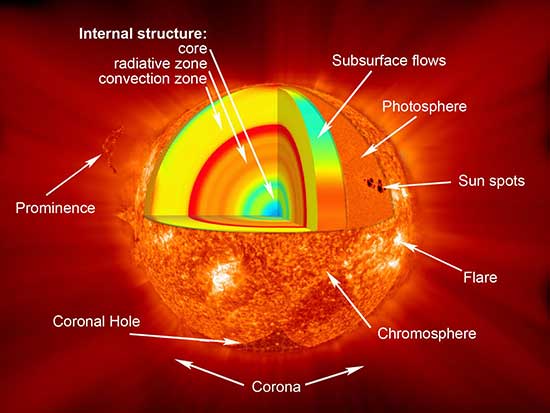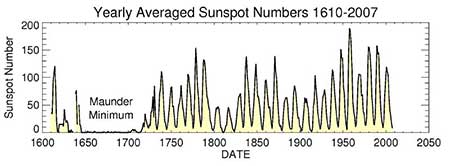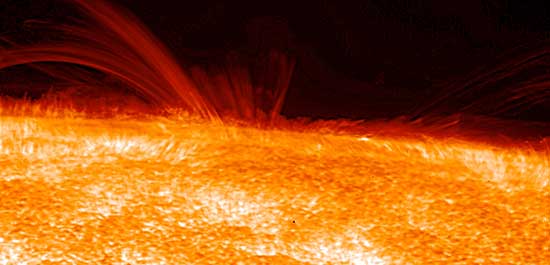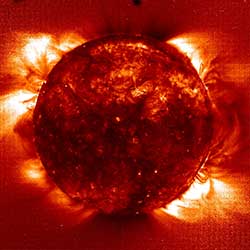The Sun
The Sun is a star, just like the ones you can see in the night sky, but much, much, much closer. In fact, our Sun is a rather ordinary star – it's not particularly big or particularly small, it's not particularly young or particularly old. Just an ordinary, run-of-the-mill star. However, since it is so close to Earth, it is the one star that we can mostly easily study. From it we have learned a great deal about the physical processes that determine the structure and evolution of stars in general.
Credit: NASA
The Sun contains the same basic elements that we find on Earth, but in vastly different quantities than what we see around us. The Sun contains about 92% hydrogen and 8% helium, with just a tiny bit of the other common elements we find on Earth. Compare that to Earth, where the most common elements are oxygen, magnesium, silicon, and iron. On Earth, hydrogen barely makes the top 10 list of common elements, and helium is extremely rare.
The parts of the Sun that we can observe and measure directly are contained in the Sun's atmosphere: the photosphere, chromosphere and corona. These regions have substantially different properties from each other, with regions of gradual transition between them.

The Photosphere
Since the Sun is made up of hot gas, there isn't really a "surface" to it. Instead, as you move from space toward the Sun's core, the gas gets denser and denser. The photosphere represents the depth at which we can see no deeper toward the core of the Sun. It's a little like watching someone walk into fog on a dreary morning - for a while they remain visible, but once they get deep enough into the fog, they disappear, and you can't see any deeper into the fog.
The Sun's atmosphere changes from transparent to opaque over just a few hundred kilometers, so the photosphere is about 500 kilometers thick. When we speak of the size of the Sun, we usually mean the size of the region surrounded by the photosphere.
Most of the Sun's radiation escapes from the photosphere and is detected as sunlight that we observe here on Earth. In addition, the photosphere is where sunspots form. Sunspots are temporary "blemishes" that appear on the Sun – they are darker than the surrounding regions and arise from intense magnetic activity.
Sunspots are regions with temperatures about 1500 K cooler than the photosphere, making them appear darker than their surroundings. A given sunspot can have a lifetime ranging from a few hours to a few months. Their sizes vary over a wide range, with a few having been measured to be 50,000 km in diameter.
German amateur astronomer Heinrich Schwabe published a paper in 1851 in which he observed that the number of sunspots visible on average varied with a period of about 10 years. Over the 140 years since then, astronomers have confirmed the presence of a solar cycle, with the number of sunspots peaking about every 11.1 years. However, in that time, a cycle has been seen as short as 8 years and one as long as 16 years.
During the maximum of the cycle, sometimes more than 100 sunspots can be seen on the Sun at once. During the minima, the Sun can sometimes have no spots at all. This cycle is closely related to the magnetism of the Sun. In fact, it is the changing magnetic field of the Sun which governs many aspects of solar activity.

The photosphere overall has a pressure of about a few hundredths of the sea-level pressure on Earth, a density of about a ten-thousandth of the Earth's sea-level atmospheric density, and a temperature in the range 4500-6000 Kelvin.
The Chromosphere

The chromosphere is the second layer of the Sun's atmosphere, and extends from the photosphere about 2,000 kilometers out. The density of gas in the chromosphere decreases rapidly as you move away from the photosphere. The chromosphere is essentially transparent to most visible radiation, so that light emitted by the photosphere just passes right through the chromosphere. In fact, even visible light emitted by the gasses of the chromosphere are generally too weak to be seen against the backdrop of the photosphere. During a total solar eclipse, when the Moon covers the photosphere from our view, the chromosphere can be seen as a red rim around the Sun.
The chromosphere is also the location of solar activity. For example, solar prominences rise up through the chromosphere from the photosphere. In addition, long fingers of gas, called spicules, can rise up from the photosphere to the top of the chromosphere and then sink back down.
The Corona

The corona is the outermost region of the Sun's atmosphere. It extends for millions of miles into space above the photosphere. Like the chromosphere, usually we can not see it because of the brightness of the photosphere. However, during a total solar eclipse, the corona shines like a crown around the Sun.
Even though the density of the corona is very small (it's about 0.0000000001 times that of the Earth's sea-level atmosphere), it is very hot, coming it at millions of Kelvin. Because of this high temperature, most of the the radiation emitted by the corona is at ultraviolet and X-ray wavelengths.
The reason for the high temperatures of the corona is not well understood. Magnetic fields seem to play a part, but the precise mechanism is an active area of scientific research.
Another Solar Feature: The Solar Wind
The solar wind is nothing more than a stream of charged particles flowing outward from the Sun with an average velocity of about 400 km/sec. It is a natural consequence of the Sun being so hot – the corona gas has too much energy to be gravitationally bound to the Sun.
Updated: February 2014
Additional Links
- Quiz me about this topic!
- Cool fact about this topic!
- Try this!
- FAQs on the Sun and the Solar System
- Give me additional resources!


